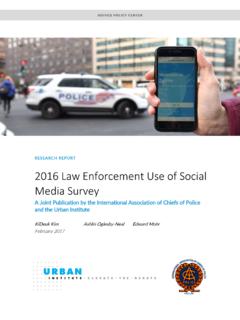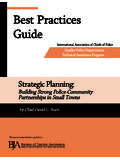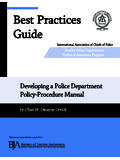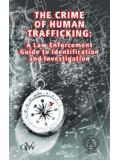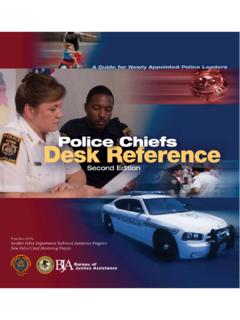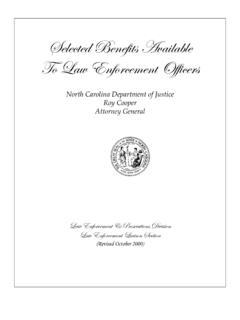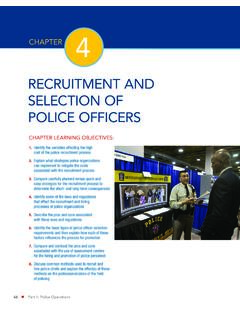Transcription of Best Practices Guide
1 Best Practices Guide International Association of Chiefs of Police Recruitment, Retention, and Turnover of Law enforcement Personnel by W. Dwayne Orrick This project supported by a grant from: SSmmaalllleerr PPoolliiccee DDeeppaarrttmmeennttss TTeecchhnniiccaall AAssssiissttaannccee PPrrooggrraamm- 1 - Best Practices Guide for Recruitment, Retention, and Turnover of Law enforcement Personnel W. Dwayne Orrick Recruiting sufficient numbers of qualified applicants to meet the staffing needs of an agency is the most fundamental human resource process in a police department. The success of the department s recruitment efforts impacts every other function in the agency. For years, law enforcement agencies offered good, stable employment.
2 A readily available workforce enabled many police leaders to ignore the importance of recruitment. Today, employers nationwide, including police departments, report having difficulty attracting and retaining sufficient numbers of qualified employees. There are a number of factors both inside and outside the organization contributing to this condition. The purpose of this Guide is to provide an overview of the issues that impact an agency s ability to recruit sufficient numbers of qualified persons who are a good fit within a police agency and the processes to successfully attract these individuals. In addition, factors contributing to increased levels of employee attrition and processes for developing a high retention environment will be identified.
3 Recruitment Police departments are service organizations. The quality of their service delivery is directly linked to the quality of personnel they recruit, hire, and retain. Failing to recruit and retain personnel that fit with the agency will have a direct impact on the organization s ability to serve their community. The process of attracting potential employees is more complex than merely convincing a large number of persons to submit an application for employment. To be more effective, agencies must view recruitment in a comprehensive manner. Before a department begins to recruit officers, the number of officers and the needs of the department should be identified through a staffing analysis and a review of the average turnover rates.
4 Once the number of employees that are needed is identified, the core values of the organization and the unique aspects, or employer brand , should be clarified. This information is critical for establishing the caliber of officers needed and what the department has to offer employees. In addition, leaders must designate specific individuals to act as official department recruiters, but every officer can be enlisted to help with the search. Finally, the process of actually recruiting employees should make use of a variety of recruitment strategies. Staffing Analysis To determine the number of officers required to serve the needs of the community, the department should conduct a staffing analysis.
5 There are several formulas available for projecting the number of employees needed. Assuming the department receives appropriations to fund additional positions, the projected need is added to the number of current vacancies. At the same time, the average turnover should be determined. To estimate the anticipated vacancies, planned and unplanned turnover must be considered. Planned attrition includes persons who are known to be leaving the department in the next 12 18 months ( retirement). Reviewing the average number of persons who resigned in the past 24 36 months can be used to estimate the number of unplanned turnover. Combined, the staffing projection, current vacancies, and estimated turnover provide recruiters with the approximate number of new officers that will need to be recruited.
6 - 2 - Identifying Core Values The process of identifying the core values of a police department is often viewed as being the softer side of law enforcement that has little affiliation with real police work. However, the statement of core values is actually the bedrock of the department s operations. Serving as its constitution, the core values clarify why the department exists, what it represents, and how it conducts itself. While there are many similarities between law enforcement agencies, there are distinct differences between each community s expectations and how its department provides services. Every agency has a set of values, regardless of whether they have been formally articulated and pronounced. Identifying the core values helps to determine what beliefs an individual should possess to fit well within the organization.
7 This is important because many leaders have been led to believe that a person who passes the various selection procedures is the most qualified person for the department. In reality, an officer who works well in one department may not fit well in another. The core values establish the standard for evaluating the recruitment and selection of employees. When organizations fail to identify core values and make them an integral part of the recruitment, selection, and operational procedures, they tend to repeatedly make the same hiring mistakes. 1 Finally, when employees personal values are similar to those represented by the police department the individual is more likely to identify with the agency s purpose and be anchored to that This results in lower attrition rates.
8 Developing an Employer Brand As agencies place greater emphasis on recruiting and retaining employees, they should examine their employer brand. An employer brand communicates the message of what it is like to work in the organization. Every department has a reputation as a place to work that may be positive or negative. For example, a department may be well-known for providing higher salaries, maintaining excellent performance standards, or having the best equipment available . At the same time, a department may also be known for poor relationships between management and line officers or low salaries and benefits. Agencies that develop a strong, positive employer brand have a special allure as a great place to work and are considered employers of This designation gives agencies a competitive advantage when recruiting officers.
9 As a result, departments are more likely to have a greater number of high-quality candidates apply for positions. Branding also helps lower the cost-per-hire and increases the level of retention by initially attracting candidates who are more likely to be a good fit for the As departments seek to develop a strong employer brand, they should go through a facilitated process to gain employee participation, identify what candidate s desire, assess the department s current brand, and clarify the agency s unique characteristics. Having completed this process, agencies can work to develop the department s desired image. Once established, a strategic plan to move from the current brand to the desired image can be developed.
10 This process is not easy and cannot be accomplished overnight. Once the desired brand is created, the agency must constantly work to maintain it. In addition, they must ensure how the employees act and the public s perception of the department are synonymous with the brand. Agencies that successfully complete this effort find they have better relations in the community, successfully recruit top quality candidates, and are in a stronger position to retain quality candidates. Recruiter Selection Many agencies fail to recognize and subsequently stress the importance of the recruitment function. As a result, those persons who would probably be the best individuals for the position do not submit their name for consideration.
